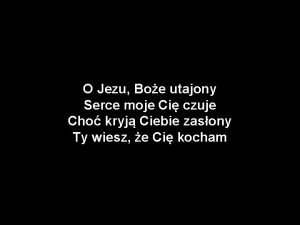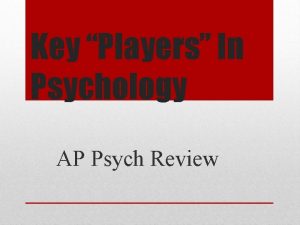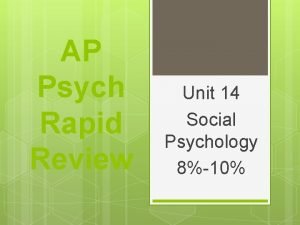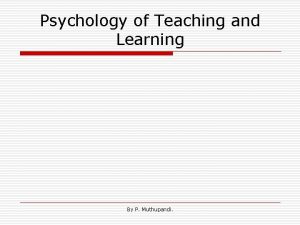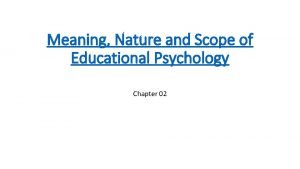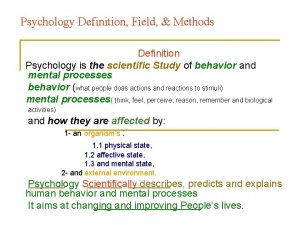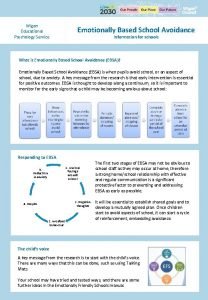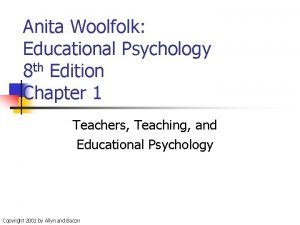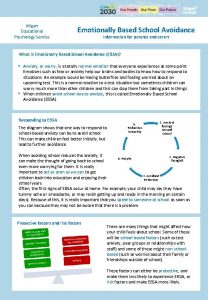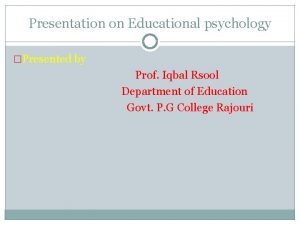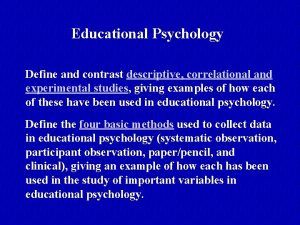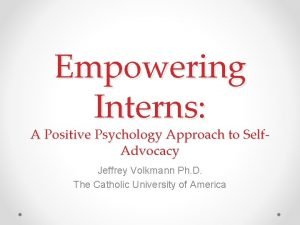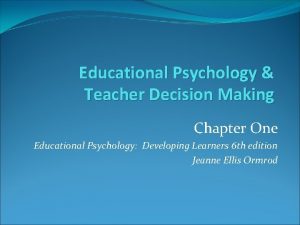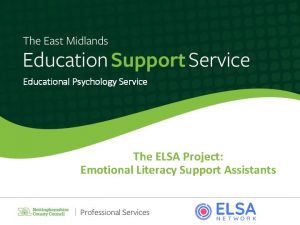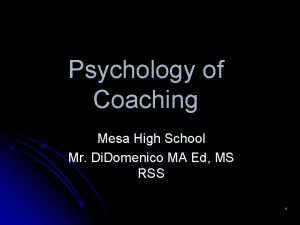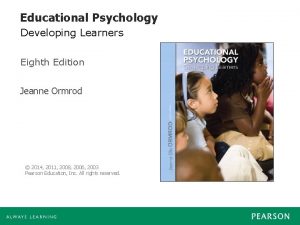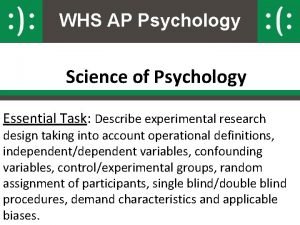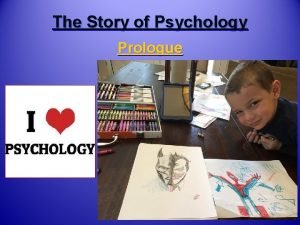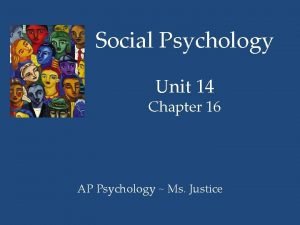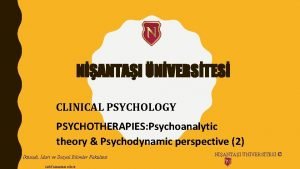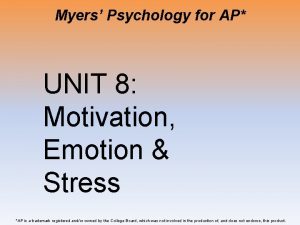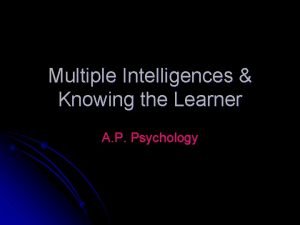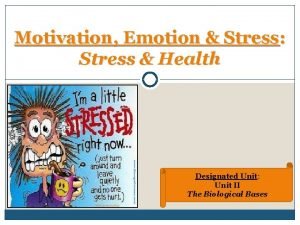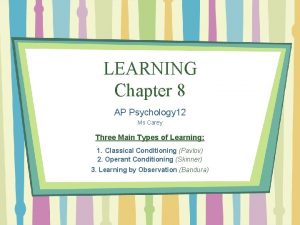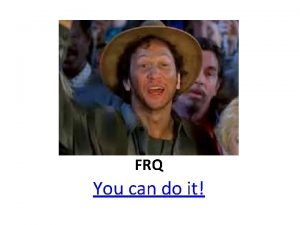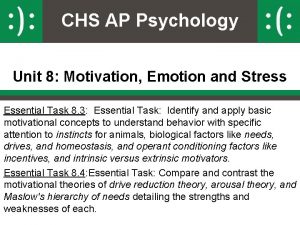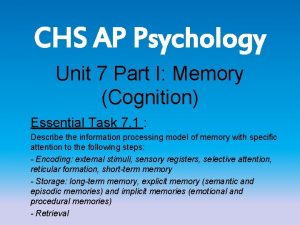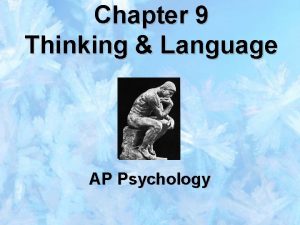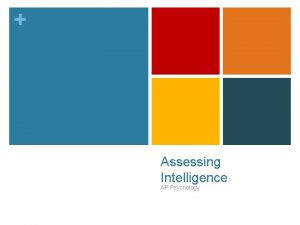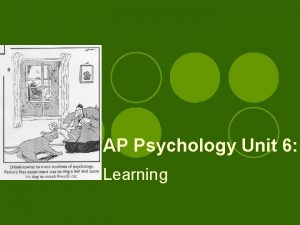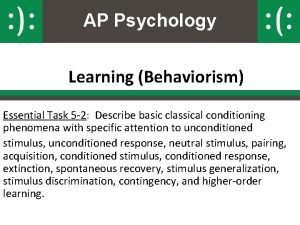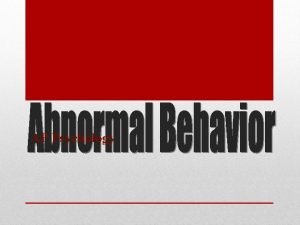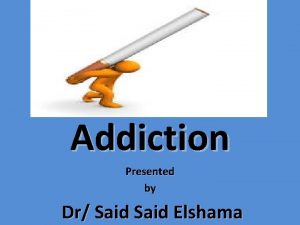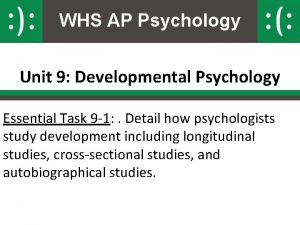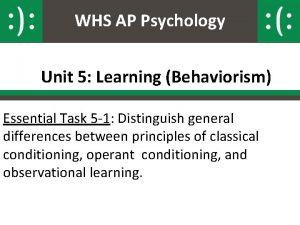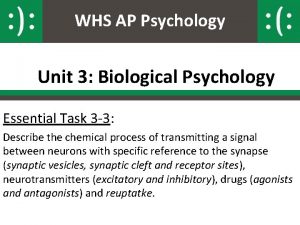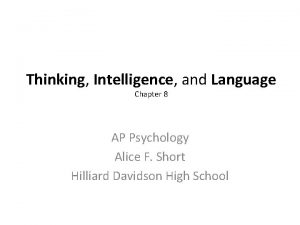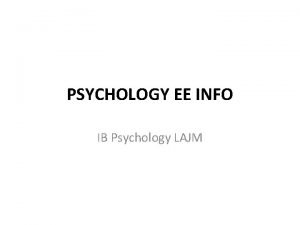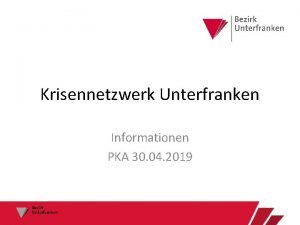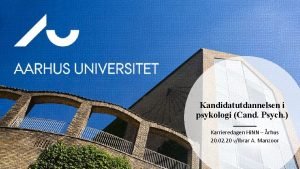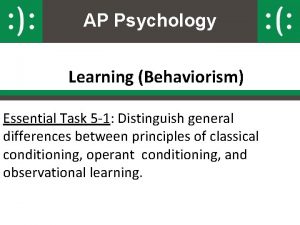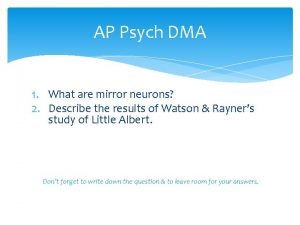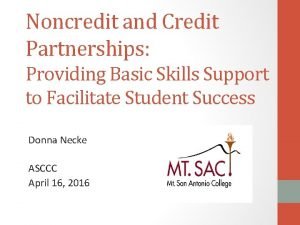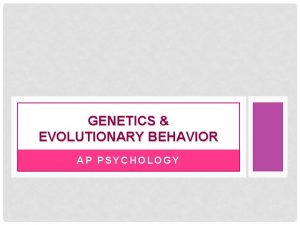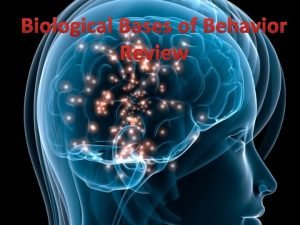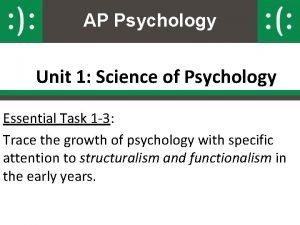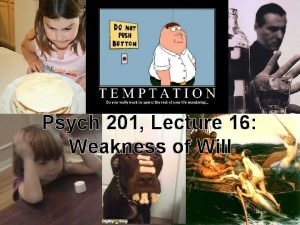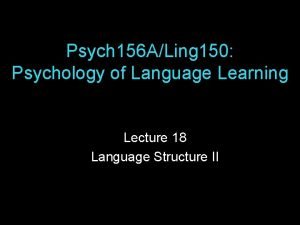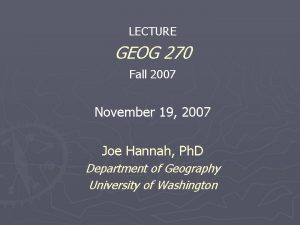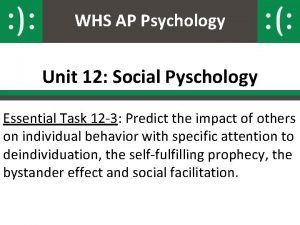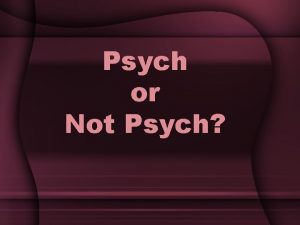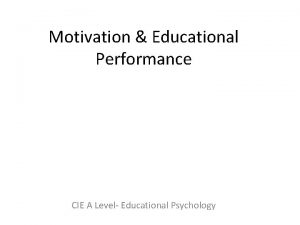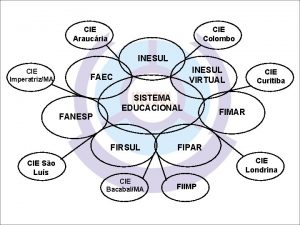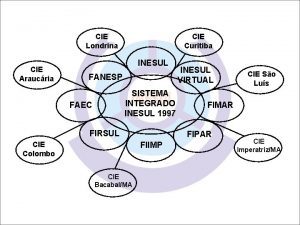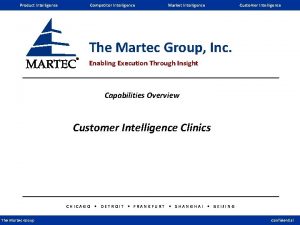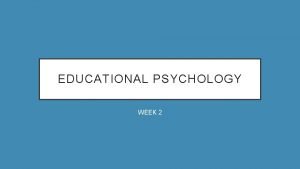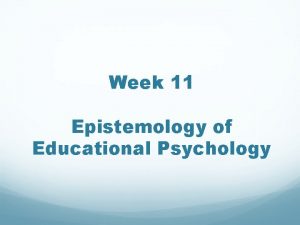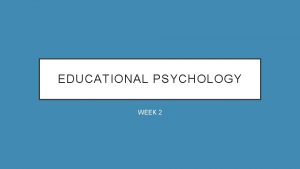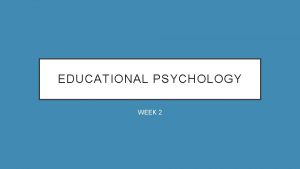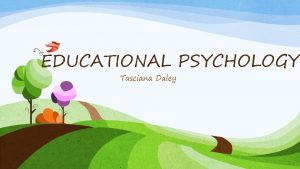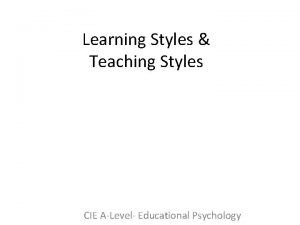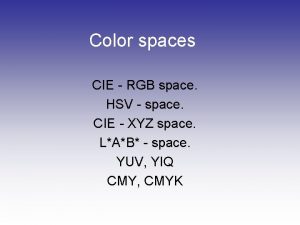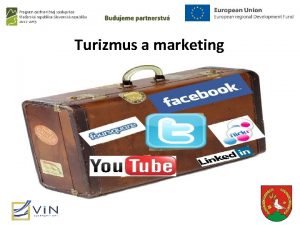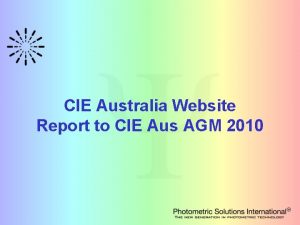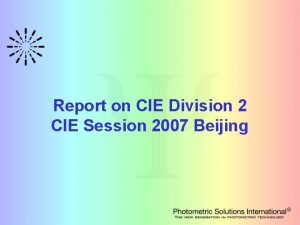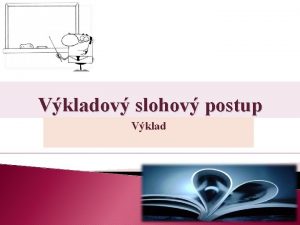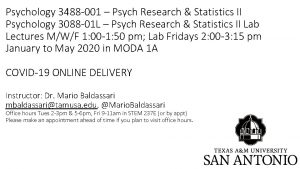Intelligence CIE A Level Psych Educational Psychology CIE






























































- Slides: 62

Intelligence CIE A Level Psych- Educational Psychology

CIE Syllabus Components for Intelligence Topic 1: Concepts, Types, and Tests of Intelligence Concepts of Intelligence and IQ Types of Intelligence Tests: Stanford-Binet, Wechsler (WAIS & WISC), & British Ability Scale (BAS) Reliability, Validity, & Predictive Validity Intelligence & Educational Performance Topic 2: Theories of Intelligence Factor-Analytic Approach (Cattell, 1971) Multiple Intelligences (Gardner, 1983) Triarchic Theory (Sternberg, 1988) Topic 3: Alternatives to Intelligence Emotional Intelligence (Goleman, 1995) Creativity & Unusual Uses Test (Guilford, 1950) Problem Solving Techniques- Means-End Analysis, Planning Strategies, Backwards Searching

CIE Syllabus Components Topic 1: Concepts, Types, and Tests of Intelligence Concepts of Intelligence and IQ Types of Intelligence Tests: Stanford-Binet Wechsler (WAIS & WISC) British Ability Scale (BAS) Reliability, Validity, & Predictive Validity Intelligence & Educational Performance

Concepts of Intelligence and IQ • There is not a single, agreed upon definition – often shaped by the culture in which we live in • *Most used definition: Intelligence is the ability to learn from experience, solve problems, and use knowledge to adapt to new situations • Sternberg (1985) has defined intelligence as the use of our knowledge and skills that help us tackle problems and tasks in every day life

Concepts of Intelligence and IQ • Aside from defining intelligence, the long-standing question is how to ‘measure’ intelligence • Most widely accepted is the use of Stern’s IQ score – IQ= mental age/chronological age × 100 • The average IQ is 100 and the scores are standardized so that about 64% of the population have a score between 85 and 115 • http: //positivemed. com/2013/12/04/12 -interesting-facts-iq/ • https: //www. youtube. com/watch? v=9 x. Tz 3 Qjclo. I&list=PL 8 d. Puua. Lj Xt. OPRKz. VLY 0 j. JY-u. HOH 9 KVU 6&index=23

Concepts of Intelligence and IQ

Concepts of Intelligence and IQStanford-Binet Test • Stanford-Binet IQ Test – Alfred Binet was commissioned by ze French government in 1904 to create a test that would determine placement of students for either the regular curriculum or a special one – Binet and his colleague, Theodore Simon, devised the idea of ‘mental age, ’ the performance level typically associated with a certain chronological age • Such as an the mental activities that an 8 year old would be able to accomplish. If a 6 year old could perform at this level, the child would be able to do well in school work. But, if a 10 year old couldn’t perform at that level, s/he would have difficulty in school.

Concepts of Intelligence and IQStanford-Binet Test • The original version of the test, published in 1905, had 30 categories such as 'Recognition of Food' and 'Repetition of Sentences of Fifteen Words'.

Concepts of Intelligence and IQStanford-Binet Test • Lewis Termin (from Stanford U) in 1916 added to & modified Binet’s original test as the original questions and age norms for ze French children didn’t fit in CA • Termin also extended the upper end of the test’s range from teen to ‘superior adults’. • From this updated IQ test, William Stern soon added IQ • The test most recently was revised in 2003 • Current Stanford-Binet test has 4 parts: verbal reasoning, abstract/visual reasoning, quantitative reasoning, and short-term memory

Concepts of Intelligence and IQStanford-Binet Test • Original test worked fairly well with kids, but not adults • Negatives included the ‘use’ for eugenics, immigration discrimination, and placement for WWI soldiers – Other psychologists set out to devise a ‘better’ test • Currently, the Stanford-Binet test and others no longer compute one’s actual IQ itself • Instead, the results represent the test taker’s performance relative to the average performance of others of the same age (with 100 as the mean)

Concepts of Intelligence and IQWeschler (WAIS & WISC) • WAIS & WISC • In 1939, David Weschler developed the Weschler-Bellevue test in response to the Stanford-Binet test only being for children and relying too much on language ability • The WAIS (Weschler Adult Intelligence Scale) was released in 1955 and soon became the foremost IQ test for adults • The WISC (Weschler Intelligence Scale for Children) as well • Currently, the revised editions are the WAIS-IV (2003) and WISC-IV (2008)

Concepts of Intelligence and IQWeschler (WAIS & WISC) • Both the WAIS and WISC are divided into 2 parts: – Verbal scale: • • Information- general knowledge about the world Comprehension- ability to use past experiences to answer questions Arithmetic- verbal problems that are number based Similarities- asks about ways that objects and/or concepts are similar Digital span- repetition of a series of numbers Vocabulary- tests of definitions of words Letter number sequencing- letters/numbers presented orally as the person has to recite them back in numerical & alpha order

Concepts of Intelligence and IQWeschler (WAIS & WISC) • Both the WAIS and WISC are divided into 2 parts: – Performance scale: • Digit symbol- various shapes are given numbers and the person has to recall the shape of a certain number • Picture completion- missing part of a picture to be discovered and named • Block design- design from a picture must be built with blocks • Picture arrangement- scrambled pictures arranged in correct order • Matrix reasoning- geometric shape to be selected from a range of alternatives • Object assembly- pieces of a puzzle to be arranged into one whole • Symbol search- matching new symbols to previously seen ones

Concepts of Intelligence and IQWeschler (WAIS & WISC)

Concepts of Intelligence and IQWeschler (WAIS & WISC) • A person’s IQ is calculated based on the individual’s performance across all of the tests – Enables one’s strengths & weaknesses to be seen – Enables parents/teachers to work with student in lower areas • The Weschler tests were designed to have a fixed average point of 100 – Also introduced the deviation IQ (of 15) that is commonly used to classifying numerical results into labeled categories • The WAIS has to be updated every ten years or so because of the Flynn effect

Concepts of Intelligence and IQBritish Ability Scale (BAS) • Originally developed in 1979, BAS consists of 23 tests aimed at school-aged children (up to 18) to measure a wider diversity of mental abilities than the WISC – Similar to WISC in targeted audience • The BAS yields an overall score- the GCA (General Conceptual Ability)- and also provides component scores that allow for the highlighting of the child’s strengths & weaknesses • The test provides a Verbal IQ, Visual IQ, and General IQ

Concepts of Intelligence and IQBritish Ability Scale (BAS) • The main focus of the BAS is divided into 2 categories: – Core scales- 6 cognitive tests measuring verbal ability, non-verbal reasoning ability, & spatial ability (2 each) – Diagnostic scales- measure specific cognitive abilities • Can measure abilities such as object recall, picture recognition, number concepts, etc • Collectively, these scales focus on speed of information processing, reasoning, spatial imagery, perceptual matching, short-term memory, and retrieval and application of knowledge

Concepts of Intelligence and IQReliability, Validity, & Predictive Validity • Psychometric test- standardized procedure for measuring facets such as memory, intelligence, aptitude, personality, etc. – This include IQ tests, MBTI, Rorschach, MMPI, TAT, etc. • Reliability- the consistency of a test (should give the same or similar result when applied on different occasions) • Validity- the test measures what it claims & is accurate in doing so – like personality with MMPI or intelligence with WAIS, WISC, or BAS – Can be accomplished with test-retest methodology • Predictive Validity- test’s ability to predict specific behavior that the test is supposed to be measuring – Like SAT in predicting college GPA- today about a 0. 4 correlation

Concepts of Intelligence and IQReliability, Validity, & Predictive Validity

Concepts of Intelligence and IQReliability, Validity, & Predictive Validity • Evaluating Reliability & Validity: – https: //www. youtube. com/watch? v=75 g 4 d 5 s. F 3 x. I&list=PL 8 d. Puua. Lj. Xt. OPRKz. VLY 0 j. JY-u. HOH 9 KVU 6&index=24 – Reliability in IQ testing: • Myers (1998) found that the Stanford-Binet, WAIS, and WISC have reliability scores of +0. 9 – Ethnocentric Bias: • As shown with Terman having to modify the original Binet test • It is not uncommon for ‘Western’ ideas of intelligence to be looked at in a higher light than other parts of the world • Depends on who is administering the test and what the target population is- think immigration – Labels are sticky once again

Concepts of Intelligence and IQReliability, Validity, & Predictive Validity • Evaluating Reliability & Validity: – Issues of Test Parameters: • Though tests like the IQ have different scale discriminations, such as ‘above average’ and ‘gifted, ’ one cannot definitively say that the scale breakdowns are absolute

Concepts of Intelligence and IQIntelligence & Educational Performance • Sternberg (1991)- meta-analysis of 29 studies – Found an overall +0. 45 correlation between IQ scores and educational attainment • But there were differences that pertained to the samples looked at, the tests being used, and how educational performance was measured – Noted that none of the studies used a sample representative of the country as a whole • Nasser (2012)- found gender differences in IQ, math, & effort – Boys with higher IQs performed better on math test due to more effort (as compared to boys with lower IQs and less effort) – For girls, groups of high and low IQ gave the same amount of effort, but the higher IQ group performed better • Duckworth (2012)- longitudinal study reporting that IQ scores are better predictors of performance on standard tests than effort

CIE Syllabus Components Topic 2: Theories of Intelligence Factor-Analytic Approach (Cattell, 1971) Multiple Intelligences (Gardner, 1983) (*Sorry Kelly, not you) Triarchic Theory (Sternberg, 1988)

Theories of Intelligence: Factor-Analytic Approach • The use of factor-analysis in intelligence is based on the idea that there are different clusters of intelligent behaviors and skills that can be measured on any test • The use of this statistical techniques allows professionals to see strong correlations b/w specific items, thus which ‘factor’ is dominant (like problem-solving skills)

Theories of Intelligence: Factor-Analytic Approach • Spearman (1904) originated the factor analysis approach – Sought to find out if there any determining general factor or whethere are clusters of different abilities – During his research, he noted that when someone scored high in one area (like verbal intelligence), they often scored above average in other areas – Concluded that we have one factor- g (general intelligence)

Theories of Intelligence: Factor-Analytic Approach • Thurston soon disagreed, saying that instead there were 7 factors of intelligence – Based upon the results of 56 different tests that he gave to volunteers – Yet when independent researchers examined Thurston’s results, they found that when test takers excelled in one area, they typically did well on the other areas, supporting the g concept

Theories of Intelligence: Factor-Analytic Approach (Cattell, 1971) • Raymond Cattell expanded Spearman’s concept of g – Said that general intelligence is a mix of almost 100 abilities – These abilities all mix to bring out different intelligences – From his factor analysis of the relationships between the different skills associated with intelligence, Cattell concluded that intelligence is unitary • In other words, a person who is mathematically intelligent is statistically also more likely to be good at English, science, etc. • Proposed the concepts of Fluid Intelligence (Gf) and Crystallized Intelligence (Gc) – These are viewed as 2 different sets of abilities – The types of intelligence change from childhood through adulthood

Theories of Intelligence: Factor-Analytic Approach (Cattell, 1971) • Fluid Intelligence – The ability to think on the spot and solve novel problems • The ability to perceive relationships • The ability to gain new types of knowledge • Seen to begin to decline in a person around age 40 • Examples for measuring Gf – The ability to assemble novel puzzles – The ability to determine the next entry in a series of numbers – The ability to identify which one of four objects is related to the others – Soduko (or something similar where you have to think in a new/different way)

Theories of Intelligence: Factor-Analytic Approach (Cattell, 1971) • Crystallized Intelligence – Factual knowledge about the world • The skills already learned and practiced (influenced by education & culture) • Seen to be stable in a person throughout life • Examples – Arithmetic facts – Knowledge of the meaning of words – State capitals

Theories of Intelligence: Factor-Analytic Approach (Cattell, 1971)

Theories of Intelligence: Factor-Analytic Approach (Cattell, 1971) • Strengths of Factor-Analytic Approach – Very scientific- uses objective, quantifiable measurements • Use of test scores and statistics for correlations – Supported by large amounts of scientific data – Objective and unbiased • Weaknesses of Factor-Analytic Approach – Large-scale statistical analyses of people's intelligences ignores each individual's unique set of talents (think multiple intelligence) – Reductionist- individual skills & talents are reduced to a single 'general intelligence' – The theory reifies intelligence (treats an abstract concept as though it is real and definitively measurable) – Tests used to measure IQ may be ethnocentrically biased

Theories of Intelligence. Multiple Intelligences (Gardner, 1983) • Theory proposes that we have seven different types of intelligence that allow a person to solve problems & create products that are valued within one’s culture • As opposed to g theory, different types of intelligence are not related to each other – Gardner says that we can be good at one skill without it being more likely that we are good at other things as well • Gardner stressed that intelligence is defined within the context of culture – What is intelligent for one culture may not be so for another

Take this online MI test: http: //www. literacynet. org/mi/assessment/findyourstrengths. html

Theories of Intelligence. Multiple Intelligences (Gardner, 1983) • Linguistic: speech production, syntax, and semantics – Capacity to use language effectively as a means of expression & communication through the written or spoken word – Examples: poets, writers, orators, and comedians • Logical-Mathematical: use of logic & math to help solve problems – Ability to recognize relationships & patterns between concepts and things, to think logically, to calculate numbers, and to solve problems scientifically and systematically – Examples- mathematicians, economists, lawyers and scientists

Theories of Intelligence. Multiple Intelligences (Gardner, 1983) • Spatial: ability to perceive spatial information & recreate visual images in our “minds eye” and ability to rotate shapes visually – Capability to think in images, orient oneself spatially, & able to graphically represent their visual and spatial ideas – Examples- artists, decorators, architects, pilots, sailors, surveyors, inventors, and guides • Musical: ability to create/understand sounds – Capacity to appreciate a variety of musical forms, ability to use music as a vehicle of expression – Examples- singers, musicians, and composers

Theories of Intelligence. Multiple Intelligences (Gardner, 1983) • Bodily-Kinesthetic: ability to use movement & the body to solve problems – Capacity of using one's own body skillfully as a means of expression or to work with one's body to create or manipulate objects – Examples- dancers, actors, athletes, sculptors, surgeons, mechanics, and craftspeople • Interpersonal (Social): recognizing/understanding the beliefs, behaviors, feelings, and intentions of others – Capacity to appropriately and effectively communicate with and respond to other people and being able to work cooperatively with others and understand their feelings – Examples- sales people, politicians, religious leaders, talk show hosts, etc.

Theories of Intelligence. Multiple Intelligences (Gardner, 1983) • Intrapersonal: understanding our own feelings and intentions – Capacity to accurately know one's self (knowledge of one's strengths, motivations, goals, and feelings) and to be capable of self-reflection and to be introverted and contemplative are also traits held by persons with Intrapersonal intelligence – Examples- entrepreneurs, therapists, philosophers, etc. • Naturalistic: understanding nature & seeing patterns in the way nature works – Ability to identify & classify the components that make up our environment – This intelligence would have been especially apt during the evolution of the human race in individuals who served as hunters, gatherers, and farmers – Examples- botanists, farmers, etc.

Theories of Intelligence. Multiple Intelligences (Gardner, 1983) • Case study: Kim Peek (real-life inspiration for Rain Man) • This savant example and others served as evidence for Gardner • Highlights of Peek: – – – In 8 -10 seconds, he could read and remember a page of writing He was able to read two pages simultaneously He could provide exact map directions and details Couldn’t button his shirt and struggled with abstract concepts Once when told by his dad to lower his voice in a restaurant, he slid down in his chair to talk

Theories of Intelligence. Multiple Intelligences (Gardner, 1983) • Strengths of Multiple Intelligence Theory – High levels of face validity • The theory seems to match our experience of the world where some people have different sets of skills (i. e. Liam Neeson) compared to others – The theory is not culturally bound, avoiding the criticism of ethnocentrism – The theory has can be very easy to apply and is now widely used in businesses and schools worldwide

Theories of Intelligence. Multiple Intelligences (Gardner, 1983) • Criticisms of Multiple Intelligence – Very little scientific evidence in testing MI – Research and testing has not supported 8 separate intelligences, but instead still an over-arching g – These ‘intelligences’ are viewed by many to be talents instead of a true, separate intelligence – Use of case studies to support theory may lack generalizability – MI theory ‘dumbs-down’ the curriculum to make all students mistakenly believe they are smart – Categories are seen as vague

Theories of Intelligence. Triarchic Theory (Sternberg, 1988) • Sternberg defines intelligence as mental skills that enables one to adapt to and succeed in real-world environments – Predicts that intelligent people make the most of strengths and work on compensating for their weaknesses • Sternberg’s theory ‘fits in between’ the traditional g and multiple intelligence theories – Critiqued MI theory saying that they are instead talents/abilities – Similar to Cattell in thinking that intelligence is a general concept, but that it could be broken-down into 3 main abilities

Theories of Intelligence. Triarchic Theory (Sternberg, 1988) • Triarchic Theory’s 3 Types of Intelligence: – Analytical (academic problem-solving)- assessed by intelligence tests that have a single correct answer to a well-defined problem (like on an IQ-test) • evaluate, analyze, compare, and contrast information – Creative- demonstrated in reacting adaptively to novel situations and generating novel ideas • generate invention, discovery, and other creative endeavors – Practical- skills required for everyday tasks that may be ill-defined and have multiple solutions (street smarts) • ties everything together by allowing us to apply what we have learned in the appropriate setting

Theories of Intelligence. Triarchic Theory (Sternberg, 1988) • One’s analytical, creative, and practical abilities function collectively to allow for success within particular sociocultural contexts

Theories of Intelligence. Triarchic Theory (Sternberg, 1988) • Implications for the classroom: – Teaching for all types of intelligence allows students to capitalize on their strongest abilities while working on their weaknesses – Teachers should know the learning preferences of their students and, when possible, capitalize on them – As variable abilities exist, it would be optimal that use diverse assessments of school achievement (not only those that focus on traditional analytical abilities)

CIE Syllabus Components Topic 3: Alternatives to Intelligence Emotional Intelligence (Goleman, 1995) Creativity & Unusual Uses Test (Guilford, 1950) Problem Solving Techniques Means-End Analysis Planning Strategies Backwards Searching

Alternatives to Intelligence. Emotional Intelligence (Goleman, 1995) • The Five Components of Emotional Intelligence: – Self-awareness- the ability to know your emotions, strengths, weaknesses, drives, values, & goals while recognizing their impact on others. Also using gut feelings to guide your decisions – Self-management- involves controlling or redirecting your disruptive emotions and impulses and adapting to changing circumstances – Social skill/relationship management- managing relationships to move people in the desired direction – Empathy/social awareness- considering other people's feelings especially when making decisions – Motivation- being driven to achieve for the sake of achievement

Alternatives to Intelligence. Emotional Intelligence (Goleman, 1995)

Alternatives to Intelligence. Emotional Intelligence (Goleman, 1995) • Evaluating Emotional Intelligence – Strengths • Takes a holistic approach to intelligence • Has been linked to positive psychology and resilience – Weaknesses • Like MI, has been critiqued as not being an intelligence • Has not been linked to academic success (no predictive validity) • Issues of self-report methodology • Has been criticized as ‘pop psychology’ as it is a popular idea, but has not been supported by research evidence

Alternatives to Intelligence. Creativity & Unusual Uses Test (Guilford, 1950) • Guilford originally devised tests to measure different task abilities for pilot training during WWII – From this, he expanded his research into IQ testing and soon saw that creativity was not being measured • Common thought was that higher IQ = higher creativity • Devised a few ‘tests’ for creativity – Divergent Production Test • Quick responses- 1 minute to list words that begin with L & end with N • Remote consequences- what if there was no longer gravity? – Unusual Uses Test • Ps given an object and asked to come up with as many possible uses in a certain amount of time

Alternatives to Intelligence. Creativity & Unusual Uses Test (Guilford, 1950) • Unusual Uses Test – Test takers list as many possible uses for a common object, such as a cup or paperclip. – Scoring is comprised of four components: • Originality- evidence of ‘thinking different’; based on each response compared to the total amount of responses from a specific group of test takers. (0 common, 1 unusual, 2 points unique) • Fluency- number of alternatives you can think of (total of points earned) • Flexibility- ‘range of ideas’; based on the different of categories of responses • Elaboration- level of detail & development of ideas (0 = a brick as a bed, versus 2 = a brick used as a bed for a child’s dolls when the child is playing outside)

Alternatives to Intelligence. Problem Solving Techniques • In solving problems, we often use heuristics, or so-called ‘rules of thumb’ to deal with a problem – Usually based on previous experience and skill base – 'Educated guesses' or 'common sense' are both examples • Sometimes, the ‘common sense solution’ is the best • Problem solving techniques typically involve steps: – Identify/define the problem – Organize the information/resources and plan a strategy – Monitor the progress and evaluate results

Alternatives to Intelligence. Problem Solving Techniques • Means-End Analysis: – Strategy where the problem is divided into smaller, more tangible ‘sub-problems’ that are solved in order to reach the goal • Planning Strategies: – Very similar to means-end analysis, this involves the planning of sub-goals on the way to the main goal • Such as the goal of buying a car (a) get a job, (b) save $15 K, (c) decide which car, (d) buy car, and (e) avoid bike cops • Backwards Searching: – Technique where you start with the end result and reverse the steps needed to get to that final result • Such as the lily pad problem from before

Addition to Syllabus • Topics for Evaluation – Nature/Nurture Debate – Ethnocentrism – Reductionism/Holism (own your own) – Evaluation of Theory (own your own) – Evaluation of Research (own your own)

Evaluating Topics. Nature/Nurture Debate Twin studies (Support for Nature) – Studies examining reared-together identical twins have found about a +0. 85 correlation in IQ – Bouchard (1981) studied 65 pairs of reared-apart identical twins and found a +0. 72 correlation in IQ – Findings have been replicated by other studies totaling 95 pairs of reared-apart twins (Bouchard, 1990; Pederson, 1992) • These two studies show both a genetic link and also environmental factors (as reared-apart scores are lower) – Brain scans have also shown that identical twins (a) have very similar gray matter volume & (b) that there brains are virtually the same in areas for verbal and spatial intelligence

Evaluating Topics. Nature/Nurture Debate • Support for Nurture – Adoption studies: Juffer (2006) noted that adoption enhances the IQ scores of neglected and/or mistreated children – Fraternal twins (50% genetic similarity) tend to score more alike than other siblings (aside from identicals) as they are raised in the same manner – Studies have shown that programs such as Head. Start have been influential – Schooling has been linked as a leading factor in many studies • Attendance rates, classes taken, peers, etc.

Evaluating Topics. Ethnocentrism • Most commonly used IQ tests consistently have shown a difference in IQ scores among races around the world – Average IQ score of Caucasian in US is 102 – Average IQ score of African-American is 85 – Average IQ score of Latino and American-Indian is 93 – Average IQ score of Asian-American is 108 • Many critics point to issues of the tests such as wording, cultural background, experience, tester bias, and ‘overall’ bias

Evaluating Topics. Ethnocentrism

Evaluating Topics. Ethnocentrism • American-Indian children: – Better on the performance part than the verbal part of an IQ test • Latino children: – Better on the performance part than the verbal part of an IQ test • Asian-American children: – Better on the performance part than the verbal part of an IQ test • African-American children: – Better on the verbal part than the performance part of an IQ test • Overall - differences in IQ scores of children from different racial and ethnic groups describes children’s performance ONLY in the

Evaluating Topics. Ethnocentrism • One ‘reason’ for differences in results is that tests have language bias because they are in standard English and many Blacks grow up speaking a Black dialect

Evaluating Topics. Ethnocentrism • In response to these ‘culturally-biased’ tests, in particular among white and black, psychologist during the 1970 s developed others • Chitling Intelligence Test (Dove, 1971) examples • A "handkerchief head" is: – (a) a cool cat – (b) a porter – (c) an Uncle Tom – (e) a preacher • Many people say that "Juneteenth" (June 19) should be made a legal holiday because this was the day when: – – (a) the slaves were freed in the USA (b) the slaves were freed in Texas (c) the slaves were freed in California (d) Martin Luther King was born

Evaluating Topics. Ethnocentrism • Black Intelligence Test of Cultural Homogeneity • Sample of 100 -item multiple-choice test, based on items drawn from Black culture – 1. Alley Apple is -Useful for building self-esteem a) brick -But low predictive validity b) piece of fruit -Low correlation between “Black” IQ Test c) dog and achievement (Language =. 33, d) horse Math=. 18) – 2. CPT means a standard of -Students in did no better on the “Black” IQ a) time Test than on the WISC b) tune c) tale d) twist – 3. Deuce-and-a-quarter is a) money b) a car c) a house d) dice

Evaluating Topics. Ethnocentrism 1990 Data
 Zaprowadź mnie tam skąd powrotu nie ma tekst
Zaprowadź mnie tam skąd powrotu nie ma tekst Positive psychology ap psych
Positive psychology ap psych Ap psychology unit 14 review
Ap psychology unit 14 review Relationship between education and psychology
Relationship between education and psychology Meaning and nature of educational psychology
Meaning and nature of educational psychology Define psychological field
Define psychological field Educational psychology theory and practice
Educational psychology theory and practice Wigan educational psychology service
Wigan educational psychology service Woolfolk educational psychology
Woolfolk educational psychology Emotionally based school avoidance
Emotionally based school avoidance Conclusion of educational psychology
Conclusion of educational psychology Define educational psychology
Define educational psychology Conclusion of educational psychology
Conclusion of educational psychology Discuss briefly the nature of educational psychology
Discuss briefly the nature of educational psychology Educational psychology
Educational psychology Educational psychology
Educational psychology Scope of educational psychology
Scope of educational psychology Psyc 1504 learning journal unit 1
Psyc 1504 learning journal unit 1 Ormrod educational psychology
Ormrod educational psychology Independent variable
Independent variable Frankston community care unit
Frankston community care unit William james known for
William james known for Passionate love ap psychology definition
Passionate love ap psychology definition Social facilitation example psychology
Social facilitation example psychology Sop 3004 ucf
Sop 3004 ucf Projection psychology
Projection psychology Myers psychology unit 8
Myers psychology unit 8 Howard gardner ap psychology
Howard gardner ap psychology Lazarus ap psych
Lazarus ap psych Ms carey ap psych
Ms carey ap psych Jmu psych checklist
Jmu psych checklist Sodas frq
Sodas frq Near-death experiences are ap psych
Near-death experiences are ap psych Ap psychology unit 8 motivation emotion and stress
Ap psychology unit 8 motivation emotion and stress Ap psychology unit 7
Ap psychology unit 7 Syntax ap psychology
Syntax ap psychology Stanford binet ap psychology
Stanford binet ap psychology Latent learning psychology definition
Latent learning psychology definition Relative height ap psychology
Relative height ap psychology Ap psychology behaviorism
Ap psychology behaviorism Antisocial personality disorder ap psychology definition
Antisocial personality disorder ap psychology definition What is habituation in psychology
What is habituation in psychology Ap psych unit 9
Ap psych unit 9 Psychology unit 7
Psychology unit 7 Ap psychology behaviorism
Ap psychology behaviorism Ap psych unit 12
Ap psych unit 12 Ap psych chapter 8
Ap psych chapter 8 Ib psychology ee examples
Ib psychology ee examples Introduction of nursing process
Introduction of nursing process Krisennetzwerk unterfranken
Krisennetzwerk unterfranken Kandidatutdannelse
Kandidatutdannelse Representative heuristic
Representative heuristic Social learning theory ap psychology
Social learning theory ap psychology Mirror neurons ap psych
Mirror neurons ap psych Psych tech program mt sac
Psych tech program mt sac Behavior geneticists ap psych
Behavior geneticists ap psych Brain lateralization refers to the ap psych
Brain lateralization refers to the ap psych Ap psych unit 1
Ap psych unit 1 Psych weakness
Psych weakness Edo psych
Edo psych Psych
Psych Psych 270a
Psych 270a Ap psych unit 12
Ap psych unit 12
